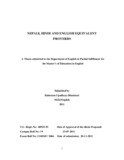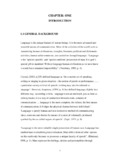Please use this identifier to cite or link to this item:
https://elibrary.tucl.edu.np/handle/123456789/234Full metadata record
| DC Field | Value | Language |
|---|---|---|
| dc.contributor.author | Upadhyay Bhattarai, Baburam | - |
| dc.date.accessioned | 2021-06-16T05:18:37Z | - |
| dc.date.available | 2021-06-16T05:18:37Z | - |
| dc.date.issued | 2011 | - |
| dc.identifier.uri | http://elibrary.tucl.edu.np:8080/jspui/handle/123456789/234 | - |
| dc.description.abstract | This thesis entitled“Nepali, Hindi and English Equivalent Proverbs” is an effort to find out the basic features of sentence-structures and the techniques of translation like addition, deletion, substitution and mistranslation of the concepts and meanings of the proverbs of the source text (Nepali)employed in the target languages(Hindi and English) texts.For this study,the researcher had collected 50proverbs of Nepali and their Hindi and English equivalent translated versions from Nepali-English Proverbial Dictionary by Sharma, J.P. (2000). Koshi Prakashan,Biratnagar and Bhargava’s Standard Illustrated Dictionary of the English language,edited by Pathak, R.C. (1965). So the required data were collected only from secondary sources. Observation was the only tool for data collection. The collected data were analyzed and interpreted in different ways. The collected data were first transliterated and categorized into simple, compound and complex sentences according to their structures. These sentences were then compared among the three languages. Negation, voice and tense of the proverbial sentences were analyzed and interpreted comparing them with one another. Among the techniques used in translating proverbs, the substitution technique was found the most widely used technique. The study has four chapters. The first chapter deals with general background,review of related literature, objectives of the study and significance of the study.The second chapter consists of methodology adopted for the study. It encompasses the sources of data, population of the study, sampling procedure, tools for data collection and limitations of the study. Chapter three encompasses analysis and interpretation of the collected data both descriptively and statistically. Chapter four comprises the major findings and recommendations made after the analysis and interpretation of the data for the purpose of the study. | en_US |
| dc.language.iso | en_US | en_US |
| dc.publisher | Department of English Education | en_US |
| dc.subject | pedagogical implications | en_US |
| dc.subject | techniques | en_US |
| dc.title | Nepali, Hindi and English Equivalent Proverbs | en_US |
| dc.type | Thesis | en_US |
| Appears in Collections: | English Language Education | |
Files in This Item:
| File | Description | Size | Format | |
|---|---|---|---|---|
| cover.pdf | 27.48 kB | Adobe PDF |  View/Open | |
| chapter.pdf | 332.65 kB | Adobe PDF |  View/Open |
Items in DSpace are protected by copyright, with all rights reserved, unless otherwise indicated.
